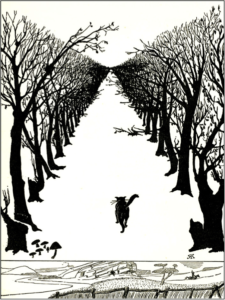by Linda Shires

What is your very first memory or impression? Is it your mother’s holding you? Your father’s singing to you? An avenue of trees? I hope yours is positive. Rudyard Kipling’s certainly was. Born in Bombay to Anglo-Indian parents, he recalled: “My first impression is of daybreak, light and colour and golden and purple fruits at the level of my shoulder” (Something of Myself for My Friends Known and Unknown, 1). After being nurtured by loving parents and a devoted ayah for his first five years, Kipling suffered a traumatic childhood when he and his younger sister “Trix” were abruptly taken to Southsea, England and left behind with paid guardians to start a British education. For the next six years he suffered cruelty and bullying. Kipling’s deep love for his own children, Josephine, John, and Elsie emerges throughout his writings, from his address to his “Best Beloved” Josephine in Just So Stories to numerous later illustrated letters from across the globe. One can only imagine the horror he and his wife felt upon burying their first daughter at age six and losing their only son at eighteen on the Western Front.
Yet what does any of this have to do with muteness, speech or survival in Kipling’s animal worlds, the topic of my recent ‘animal studies’ essay in Victorian Review? In re-reading his fiction and poetry over the last decade, I have increasingly come to question inflexible theoretical lenses used to interpret his works. Ideologies stressing binaries, including animal/human, repeatedly fail to account for the complexities, ambiguities, and ironies of his corpus.
The most acute readers of Kipling, such as Daniel Karlin or J.M.S. Tomkins, have sought in various ways to complicate binary thinking. Moreover, numerous scholars, usually focusing on the Mowgli stories, have studied his representation of animals and humans, but few have explored Kipling’s lifelong fascination with animal language or his complex depiction of muteness. Begun as an MLA talk in 2017, this essay draws upon relevant theoretical contexts to examine differing language/muteness relations among animals and humans. I argue that Kipling’s frequent reliance on muteness carries a variety of meanings and values: the silencing of non-human animal sounds by instinct; silent yet communicating animal gestures and movements; a chosen human quietude; the muting of sounds by sleep or by caresses and lullabies; the silence that follows individual deaths, mass killings, and extinctions.
I purposely begin with three of the non-Mowgli stories that were collected in the 1894 Jungle Book: “The White Seal” and “Toomai of the Elephants,” and in the 1895 The Second Jungle Book: “The Miracle of Purun Bhagat.” Each dissolves human/non-human binaries in different ways. Kipling continues to explore how and why creatures communicate in his brilliant image/text collection Just So Stories for Little Children (1902). As he still investigates language and silence, across species, years later, he creates in Thy Servant a Dog, Told by Boots (1930) an animal mind, akin to a toddler’s, trying to process human speech. Rudyard Kipling cares deeply for children, animals, and, above all, for sameness within difference—that survival matters, that we all suffer, that we all die.
To read more, see Linda M. Shires, “Kipling’s Animal Worlds: Muteness, Speech, and Survival,” Victorian Review, 46.2, pp. 191-210.
For further information, consult:
